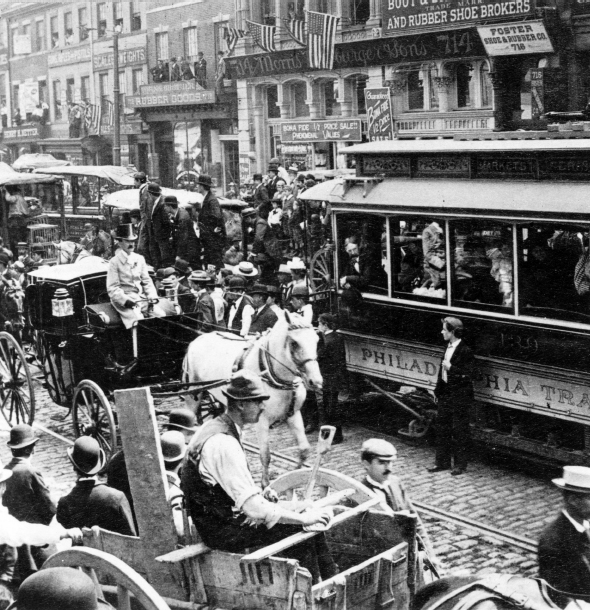Exploring American Histories: Printed Page 577
Exploring American Histories, Value Edition: Printed Page 476
Political Machines and City Bosses

City government in the late nineteenth century was fragmented. Mayors usually did not have much power, and decisions involving public policies such as housing, transportation, and municipal services often rested in the hands of private developers. For instance, by 1890 Chicago had eleven branches of government that were constantly at odds with one another. Bringing some order out of this chaos, the political machine functioned to give cities the centralized authority and services that they otherwise lacked. At the head of the machine was the political boss. Although the boss himself (and they were all men) held some public office, his real authority came from leadership of the machine. These organizations maintained a tight network of loyalists throughout city wards (districts), each of which contained designated representatives responsible for catering to the needs of their constituents. Whether Democratic or Republican, political machines did not care about philosophical issues; they were concerned primarily with staying in power.
The strength of political machines rested in large measure on immigrants. The organization provided a kind of public welfare when private charity could not cope satisfactorily with the growing needs of the poor. Machines doled out turkeys on holidays, furnished a load of coal for the winter, provided jobs in public construction, arranged for shelter and meals if tenement houses burned down, and intervened with the police and the courts when a constituent got into trouble. Bosses sponsored baseball clubs, held barbecues and picnics, and attended christenings, bar mitzvahs, weddings, and funerals, sometimes all in a single day. As George Washington Plunkitt, a boss in New York City’s Tammany Hall machine, reflected, it was a “strenuous life.” For enterprising members of immigrant groups—and this proved especially true for the Irish during this period—the machine offered upward mobility out of poverty as they rose through its ranks.
The poor were not the only group that benefited from connections to political machines. The machine and its functionaries helped businessmen maneuver through the maze of contradictory and overlapping codes regulating building and licenses that impeded their routine course of activities. In addition to assisting legitimate businessmen, the machine facilitated the underworld commerce of vice, prostitution, and gambling by acting as an arbiter to keep this trade within established boundaries—all for a cut of the illegal profits.
In return for these services, the machine received the votes of grateful immigrants and a plentiful supply of funds from businessmen. When challenged by reformers or other political rivals, the machine readily engaged in corrupt election practices to maintain its power. Mobilizing the “graveyard vote,” bosses took names from tombstones to pad lists of registered voters. They also hired “repeaters” to vote more than once under phony names and did not flinch from dumping whole ballot boxes into the river or using hired thugs to scare opponents from the polls.
Bosses enriched themselves through graft and corruption. They secured protection money from both legitimate and illegitimate business interests in return for their services. Boss William Marcy Tweed, the head of Tammany Hall in the 1860s and 1870s, swindled New York City out of a fortune while supervising the construction of a lavish three-story courthouse in lower Manhattan. The original budget for the building was $250,000, but the city spent more than $13 million on the structure, making out checks to Tweed’s phony associates “T. C. Cash” and “Philip F. Dummey.” The building remained unfinished in 1873, when Tweed was convicted on fraud charges and went to jail. In later years, Tammany Hall’s Plunkitt distinguished this kind of “dishonest graft” from the kind of “honest graft” that he practiced. If he received inside information about a future sale of city property, Plunkitt reasoned, why shouldn’t he get a head start, buy it at a low price, and then sell it at a higher figure? As he delighted in saying, “I seen my opportunities and I took ’em.” What could be more American?
Explore
See Documents 18.4 and 18.5 for opposing perspectives on machine politics.
Yet the services of political machines came at a high cost. Corruption and graft led to higher taxes on middle-class residents. Moreover, the image of the political boss as a modern-day Robin Hood who stole from the rich and gave to the poor is greatly exaggerated. Much of the proceeds of machine activities went into the private coffers of machine bosses and other functionaries and did not go to worthy public ventures. Trafficking in vice might have run more smoothly under the coordination of the machine, but the safety and health of city residents hardly improved. Most importantly, although immigrants and the poor did benefit from an informal system of social welfare, the machine had no interest in resolving the underlying causes of their problems. As the dominant urban political party organization, the machine cared little about issues such as good housing, job safety, and sufficient wages. The British observer James Bryce, who toured America in the late 1880s and admired much of what he saw, nevertheless judged the machine-controlled municipal governments to be “the one conspicuous failure of the United States.” It remained for others to provide alternative approaches to relieving the plight of the urban poor.